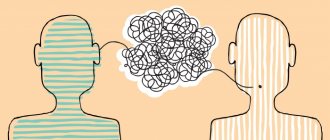What is nonverbal communication?
In simple terms, nonverbal communication is communication without the help of words.
And not only between people, but also when interacting with animals. It also helps to understand the interlocutor more deeply and express more complex feelings for which it is impossible to find words, or if a person does not realize what is happening to him, then the body gives him and those around him a hint about his condition. You might think, why do we need to know more, because verbally it’s so simple, right?
But words can deceive, and some movements and processes in the body, depending on the experience of any feeling, cannot be faked. For example, even if you adopt the posture and appearance of a frightened person, your pupils will not dilate and your palms will not sweat from fear. You can learn more about such nuances in the following article: “The most interesting features of nonverbal communication between people,” but now I suggest you familiarize yourself with the main types:
Types of nonverbal communication and manifestations
Voice
In fact, it is not only a means of communication, but also a very complex tool for a person, with the help of which he can shout, laugh, cry and, with a change in intonation or tone, makes others understand about his position and condition. For example, by the usual word: “Hello,” you can determine whether they are glad to meet you, greeted you formally, are completely unfriendly towards you, and so on.
Voice Characteristics
- Speed of speech: a fast pace indicates impulsiveness and confidence, a slow pace indicates poise and restraint. But if there are fluctuations, speech either speeds up or slows down, this signals uncertainty and the inability to control oneself due to emotions and slight excitability.
- Loudness: a loud voice belongs to a person with an active lifestyle and a lot of vital energy. A quiet voice means modesty, restraint in expressions, but jumps indicate excitement and feelings at the time of conversation.
- Articulation: Clear pronunciation indicates a desire to be understood, and incomprehensible pronunciation indicates a lack of confidence in oneself and one’s point of view.
- Height: falsetto belongs to a person with a high level of intelligence, a voice from the chest - sincere and emotional, too high, squeaky - means fear, low timbre - self-confidence, relaxation and the ability to influence others, evoke respect and admiration.
Characteristics of laughter
- Ha-ha-ha – carefree, open and cheerful.
- He-he-he - wayward, stubborn.
- Hi-hi-hi – sarcastic, malicious.
- Ho-ho-ho - boastful, rebellious.
- Hu-hu-hu - cowardice, sometimes unconscious fear.
Facial expressions
Facial expressions are facial expressions that reflect the various feelings that a person experiences. They are only expressed slightly differently on each side of the face, due to the fact that the left hemisphere of the brain is responsible for the intellectual sphere, and the right for the emotional.
Characteristics of the gaze
- Wide open eyes mean liveliness and readiness to perceive information from the outside, but too open eyes indicate increased attachment to the world.
- Squinted or intensely narrowed eyes - concentration, cunning, watching someone and signs of increased attention.
- Direct means interest and willingness to communicate.
- If they only look at you from the corners of their eyes, then know that they do not trust you and are skeptical about what you say.
- From top to bottom – excessive self-confidence, even to the point of arrogance.
- Avoiding your gaze is modesty, or living a feeling.
Characteristics of a smile
- The corners of the mouth pulled down indicate a person’s pessimism.
- Conversely, those raised up symbolize a cheerful and optimistic personality.
- A plump and soft mouth is a sign of sensitivity and increased vitality.
- Sharp, thin lips indicate intelligence and willpower.
Let's now look at how a person's feelings manifest themselves in order to better understand the behavior of the interlocutor and the thoughts and sensations he experiences, because what he says is not always true.
Showing feelings
- Anger, anger - the eyes open wide, the teeth clenched, and the gaze becomes narrowed.
- Surprise - again, the eyes open wide, only in case of surprise the eyebrows also rise and the mouth opens slightly.
- Fear - a frightened person draws his eyebrows together, his lips stretch slightly, the corners of which move downwards.
- Happiness, joy - raised corners of the lips, and a calm and open look.
- Sadness - the look seems to be extinguished, completely without interest in others, the eyebrows are drawn together, and the corners of the lips are lowered down.
- Admiration - long eye contact, with a calm gaze.
- Indignation – prolonged eye contact, without pauses, intent and slightly anxious.
- Interest in another - an attentive gaze with pauses, approximately every 10 seconds.
- Hostility manifests itself when the interlocutor looks away, not wanting to make eye contact.
Gestures and postures of nonverbal communication
If you are attentive to the behavior of another person, you will observe what position of the hands, body, what gestures he uses when interacting with you - you will be able to recognize true intentions and notice whether he is lying or really speaking sincerely.
Characteristic
- Crossing your arms over your chest means expecting something or is used as a defensive reaction. If hidden behind his back, he is not going to act or do anything now, open palms are a sign that the person is sincere at the moment, but if he hides them in his pocket, he symbolizes the desire to hide something, a feeling of uncertainty and static.
- If you notice that the interlocutor is clenching his hand into a fist, do not be alarmed; this is not always a symbol of aggression, but only a desire to master the feeling of internal anxiety and concentrate. But if the tip of the index finger and thumb touch, while the little finger protrudes, it is a symbol of very strong concentration on any details.
- If at least one hand rests on the hip, this means that the person is trying to demonstrate his superiority due to a feeling of uncertainty and embarrassment, that is, falling into a completely different polarity.
- When the hands lean on a chair, table, etc., trying to support the body in this way, this means that it is important for him to feel that there is a feeling of safety and support, then he will feel strength again.
Types of gestures
- Openness - shrugging shoulders, showing open palms and arms in general, unbuttoning shirts and other things. A person who is ready for a sincere conversation sits on the very edge of the chair to be closer to the interlocutor. When both are in a friendly mood, they will repeat each other’s movements and poses.
- Defense - arms crossed on the chest or clenched into a fist; communication in this case is unlikely to lead to a compromise.
- Evaluation, reflection - a hand resting on the cheek means that the interlocutor is in deep thought, but if the chin is supported by the palm, with the index finger extended along the oval of the face - they are critically evaluating you, not trusting you, being in the position of “we’ll see.” If your head is tilted, they are listening to you and getting involved in the process as much as possible. Reflection and the moment of choice, decision-making - when you notice that the other is scratching his chin, pacing back and forth, pinching the bridge of his nose, and if he has glasses, doing some kind of manipulation with them.
- Boredom and lack of interest - a blank look, mechanically drawing something, tapping with a foot or hand.
- Flirting - Women usually preen themselves, straightening their hair, slowly crossing their legs, stroking their thighs or calves. The behavior of men is slightly different, they straighten their tie, jacket, raise and lower their chin, straighten...
- Hiddenness, suspicion - the hand usually covers the mouth, the legs and body are turned towards the exit, rubbing the eyes, ear, nose, as well as looking away to the side.
- Gullibility - fingers connected in the form of a dome
- Self-control - hands are placed behind the lower back and hidden, or, if a person is sitting, but at the same time crosses his legs and grabs the armrests with his hands. If you notice that you are twitching your ear, this means that you have a great desire to stop talking, but you control yourself and do not allow this to happen.
- Anger and frustration - rapid breathing, tense and tightly intertwined hands, sometimes clasped, squeezing one another.
Gait characteristics
- Long steps most often characterize a purposeful, assertive and active person.
- A rhythmic gait is characteristic of those walking in a good mood.
- A clear, military-like step is a sign of strong will and determination.
- Shuffling – laziness, lack of goals and aspirations.
- Firm, tense, as if on stilts - tightness, embarrassment and lack of communication.
Characteristics of posture during sleep
- On his side, curled up, pressing something to his stomach - such a person wants help, he needs support and protection. Their body language indicates an unwillingness to take responsibility for their lives; they are sensitive and impulsive, mainly guided by desire rather than common sense.
- On your side, curled up, with your arms and legs spread out, there is balance and the ability to adapt to changes.
- On their stomachs, with their arms outstretched, they are predictable, calculating and love it when power is in their hands.
- Sociable and self-confident people sleep on their backs, with their hands under their heads; they are optimistic and loyal.
- On their sides, with their knees bent - usually balanced people who are capable of compromise and do not tolerate conflict situations rest. They are not brave enough and like to be invisible.
- With their foot off the bed, they live at a very fast pace and do not know how to pause to notice the surrounding reality.
- Wrapped completely in a blanket - shy and cowardly.
- Legs placed one on top of the other indicate that a person cannot realize something in himself or understand the events that happen to him.
- On his stomach, with his hands under him - punctual, prudent, does not like surprises, trying to predict events and their results in advance.
Theorists of the concept of cultural conditioning of facial expressions
"The Evolution of Emotions." Publishing house "Peter"
Over the past 30 years, three behaviorists—Klineberg, La Barre, and Birdwhistell—have openly disagreed with Darwin's view of facial expression. They argued that the existence of universal ways of expressing emotions through facial expressions is doubtful or unproven. The reason for the popularity of their point of view, and the ready way in which Darwin's views were rejected, was not due to the fact that these researchers were able to provide convincing evidence in favor of their point of view (their data suffers from the same shortcomings as Darwin's data). . This view was welcomed because it was consistent with some other fashionable theories in psychology and anthropology. At a time when psychology emphasized the importance of the learning factor as the only important vector of influence on human behavior, Darwin's attention to innate factors not related to learning may have seemed inappropriate to behaviorists (Klineberg's assertion that emotions are learned appealed to them much more). La Barre and Birdwhistell's contention that people express emotions differently across cultures was consistent with the trend of cultural relativism in anthropology. The concern might be that the popularity of certain ideas in the scientific community has again changed our opinion of Darwin (since now biopsychology, behavioral genetics, and ethology give the idea of universality and innate factors greater significance, at least in scientific circles), if in In our time, as we will see further in this chapter, no convincing evidence has emerged to resolve the dispute about the universality of ways of expressing emotions.
How to recognize a lie?
An interesting fact about how to recognize a lie: it turns out that sincerity or vice versa, a lie in relation to disposition towards you arises depending on the speed and simultaneity of widening the eyes and raising the corners of the mouth. For example, if you notice that the interlocutor’s eyes are slowly opening, while he rarely blinks and smiles, it means that there is a threat towards you. Or vice versa, if he allows himself to close his eyes for a short time, he trusts you and is disposed to sincere interaction.
There are also the following signs:
- Hesitation in conversation or long pauses.
- The facial expressions seemed to freeze for about 10 seconds - a clear sign of falsehood and a feigned demonstration of feelings.
- A pause between spoken words and emotional manifestations.
- Avoiding prolonged eye contact, the gaze is mostly restless.
- Few gestures or gesticulation only with the right hand, and sometimes vice versa, excessive movements and inappropriate feelings.
- Breathing is heavy, facial expressions are weak, blinking is rapid.
What factors are surprising?
Pseudo-unexpected developments of events can also be surprising, when instead of what was expected and predicted, a person encounters something new and uncharacteristic. For example, when tasting a pie with a filling that is very similar to chocolate, a person is suddenly and involuntarily surprised to discover that the dish is filled with meat and mushrooms.
Not only the physical objects of the surrounding world can be amazing, but also intangible ideas, concepts, comments and statements of other people or your own. It is precisely due to this property, such as an unexpected denouement, that detective stories are very popular. Anecdotes that exploit false expectations also have a great effect and surprise us.
The emotion of surprise will never arise where it is possible to predict and predict this or that event. On the contrary, the surprise will be more intense and longer, the fewer reasonable explanations we can give for what is happening. A surprised person becomes lost and confused until he can comprehend the entire chain of causes and consequences of an amazing event. When the latter is finally appreciated, other emotions take the place of surprise.
The emotion of surprise has a neutral charge in terms of pleasure, although sometimes we say that we are pleasantly surprised. Such pleasantness refers to a positive emotion that replaces surprise, for example, the joy of meeting an old friend. If surprise is followed by fear or disgust, then the negative is associated with surprise, which is regarded as negative from a hedonic point of view. If a person is surprised by a dangerous incident that he cannot cope with, then he experiences fear - the most common consequence of surprise. If he is able to overcome the threat and stop it, then surprise gives way to anger.
Due to its lightning speed, the emotion of surprise is quickly mixed mimically with the emotion that follows it. The observer may notice how, within a few moments, raised eyebrows and widened surprised eyes are complemented by an accompanying smile that spreads across the lower part of the face and signals joy. Instead of a smile, the corners of the mouth may move back a little, and in this case, the facial expression of surprise is combined with the facial expression of fear.
The intensity of the emotion in question varies from mild to extreme. At the peak of the startle response - extreme surprise caused by a sharp and loud stimulus - the person throws his head back, closes his eyes, closes his lips and shudders. Such an experience is always regarded as extremely unpleasant.
Often other emotions following surprise are experienced as unpleasant, but we must remember that there are people who find joy and pleasure in acute, negative sensations. They strive to experience surprise as often as possible and are prone to everything new and unknown. On the contrary, most people have a negative attitude towards the emotion of surprise and hate surprises. They strive for maximum control of any situation, which, due to this, cannot put them in harm’s way.











